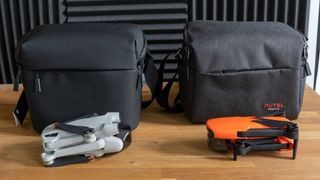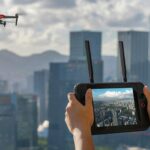Late in 2021, Autel introduced the Nano series, a lightweight drone equipped with collision sensors, challenging DJI’s then-leading ultra-light drone, the Mini 2, which lacked this crucial feature. While the Autel Evo Nano Plus impressed technologically, it also came with a higher price tag. DJI responded with the DJI Mini 3 Pro, positioning it as a professional ultra-light drone. This comparison aims to help you decide between the Autel Evo Nano+ and the DJI Mini 3 Pro.
Design and Build: Autel’s Bold Aesthetics vs. DJI’s Functional Form
Both drones weigh 249g and have similar folded dimensions. However, their designs differ significantly. Autel offers the Nano Plus in various colors, including a vibrant orange and a more stylish grey and yellow. DJI’s Mini 3 Pro resembles a compact version of the Air 2S. The Mini 3 Pro lands on nub-like legs, while the Evo Nano utilizes foldable legs on its front arms, requiring specific unfolding before takeoff. Autel thoughtfully includes a propeller strap and gimbal cover, while DJI only provides a gimbal cover. Autel batteries have built-in charge indicators, offering a convenient way to check battery levels without needing the drone itself, a feature lacking in the DJI Mini 3 Pro.
Speed and Maneuverability: A Close Contest in the Air
Both drones boast a maximum speed of around 35 mph and can handle winds up to Force 5. The Mini 3 Pro exhibited slightly better stability in strong winds. Both offer three speed modes, with DJI’s Mini 3 Pro featuring a convenient slider switch on the remote for quick adjustments. While both drones possess obstacle avoidance capabilities, they tend to slow down considerably when navigating around obstacles.
Battery Life: Balancing Flight Time and Convenience
The standard batteries for both drones provide approximately 24 minutes of flight time in ideal conditions. The Mini 3 Pro offers an optional Intelligent Flight Battery Plus, extending flight time to 47 minutes, but increases the drone’s weight above the crucial 249g limit. Autel’s batteries, while offering slightly less flight time, have the advantage of integrated charge indicators.
Gimbal and Camera: DJI’s Edge in Versatility
The Mini 3 Pro’s gimbal offers a crucial advantage: the ability to rotate 90 degrees for portrait orientation, a feature absent in the Nano Plus. The Mini 3 Pro’s gimbal also boasts a wider range of motion, providing greater flexibility in capturing creative shots.
Controller and Range: DJI Offers More Options
Both drones offer similar range capabilities, exceeding legal limits in most regions. Autel’s controller streams a higher quality live view feed (2.7K), while DJI offers two controller options: the standard RC-N1 and the new RC controller with a built-in screen, albeit at an added cost.
Still Photos and Video: Different Approaches to Image Quality
Both drones capture impressive stills and videos. The Mini 3 Pro boasts a slightly wider aperture and the ability to shoot 4K video at 60fps. However, the Nano Plus’s image processing often produces sharper results, although this sharpness might appear less natural upon closer inspection.
Software Features: DJI’s Mature Ecosystem Takes the Lead
DJI’s software features, particularly its subject tracking and obstacle avoidance capabilities, are more refined and reliable than Autel’s. While both drones offer automated flight modes (QuickShots), DJI provides a wider selection.
Verdict: The DJI Mini 3 Pro Emerges as the Victor
The DJI Mini 3 Pro, with its superior gimbal, slightly longer flight time with the optional battery, more mature software features, and versatile controller options, narrowly edges out the Autel Evo Nano Plus. While the Nano Plus offers compelling features like its compact design and integrated battery charge indicators, the Mini 3 Pro’s overall package makes it the more compelling choice for most users seeking a high-performance mini drone.


